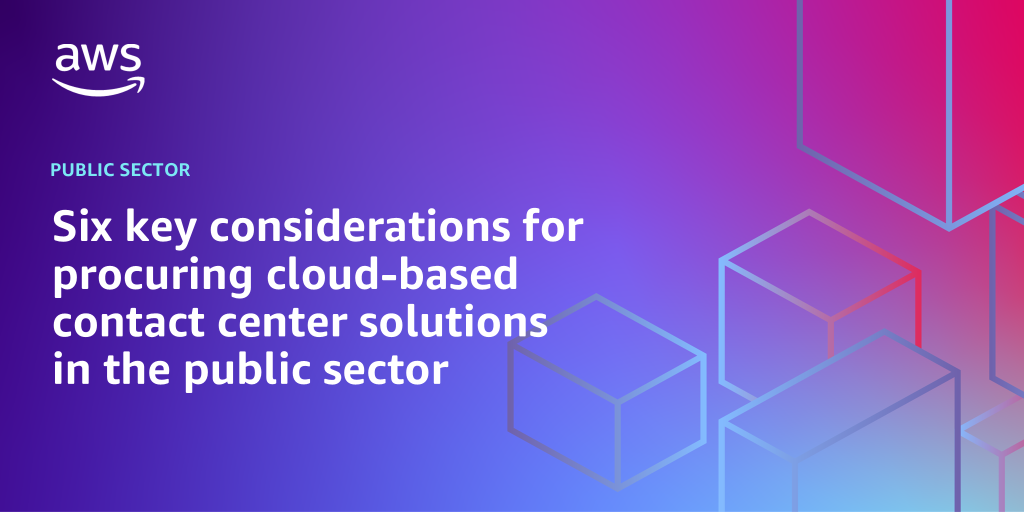AWS Public Sector Blog
Category: Messaging
How tax agencies are modernizing contact centers with Amazon Connect and generative AI
This blog post explores how the Alabama Department of Revenue (ALDOR) and the Wisconsin Department of Revenue (Wisconsin DOR) are using AWS applications and services to modernize their contact centers to improve resilience, reduce costs, and scale support for the communities they serve.
How The Coupon Bureau built a real-time universal digital coupon platform on AWS
The Coupon Bureau (TCB) is modernizing how coupons work in the US with the first universal digital coupon standard: AI (8112). To make this possible, TCB needed to build a system that could support billions of coupon transactions in real time, integrate seamlessly with hundreds of providers and retailers, and deliver mission-critical reliability. By using AWS services, TCB designed a cloud-based architecture that processes high-volume events, delivers real-time webhook notifications, provides data recovery during outages, and scales seamlessly as adoption grows.
How the City of Atlanta transformed its Department of Customer Service with Amazon Connect
The City of Atlanta worked with AWS and AWS Partners to modernize its contact center using Amazon Connect. By moving away from a patchwork on-premises system and toward a unified, cloud-based platform, the city improved its service delivery, increased scalability, and built a more resilient foundation. Read this post to learn more.
Modernizing the citizen experience with Amazon Connect: AI-powered interactions to build trust and drive mission outcomes
Government agencies struggle to modernize citizen experiences while optimizing resources, reducing costs, and enhancing security. Siloed systems, untenable volumes, reduced staff, and manual workflows create an urgent need to modernize the citizen experience and drive efficiencies by using generative AI, agentic AI, automation, and analytics—while paying only for what you use. Amazon Connect—the AWS AI-powered, comprehensive contact center as a service (CCaaS) application—transforms government contact centers of all sizes into modern, efficient, and secure service delivery hubs providing enhanced experiences. Read this post to learn more.
Six key considerations for procuring cloud-based contact center solutions in the public sector
The shift to cloud-based Contact Center as a Service (CCaaS) solutions offers significant opportunities for public sector organizations to transform their operations, reduce costs, and improve citizen services. Amazon Web Services (AWS) provides innovative cloud technologies like Amazon Connect that can help organizations achieve these goals. However, traditional procurement approaches may not be well-suited for acquiring these modern cloud technologies. To help organizations navigate this transition, we’ve identified six key considerations when procuring a CCaaS solution like Amazon Connect.
Enhancing public safety operations with Amazon Bedrock
In this post, we discuss a noise complaint solution that uses an Amazon Bedrock Agent to serve as an intelligent interface between citizens and the computer-aided dispatch (CAD) system.
Efficient large-scale serverless data processing for slow downstream systems
This post demonstrates how to build serverless workflows on AWS that process such data using AWS Step Functions and integrate with downstream systems that have concurrency limitations.
Transforming Medicaid: Crafting a robust data strategy with AWS for operational efficiency
What if a Medicaid agency could make sure that their leadership and staff had access to a reliable, single source of truth for their data in one unified platform? The implementation of an operational data store (ODS) presents a viable solution. This post explains the architectural choices available with Amazon Web Services (AWS) to effectively create and maintain an ODS.
Breaking barriers: How AWS is revolutionizing the accessibility of federal agency communications for people with visual disabilities
In this post, we discuss a solution that uses AWS services to improve government communication accessibility and meet federal accessibility requirements. The serverless architecture automates document-to-speech conversion and delivers information to citizens with visual disabilities.
Transforming Resident Outreach using next-generation AI capabilities
Deloitte’s Resident Outreach solution (available in AWS Marketplace) enables state agencies to adapt their resident communications through the power of generative AI on AWS. In this post, we discuss how Deloitte empowers the four capabilities of Resident Outreach: Multi-Modal Completion of Applications & Renewals, Application Nudges, Correspondences, and Campaigns.









